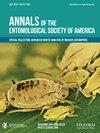Directed Sequencing of Plant Specific DNA Identifies the Dietary History of Four Species of Auchenorrhyncha (Hemiptera)
IF 1.8
3区 农林科学
Q1 ENTOMOLOGY
引用次数: 8
Abstract
Abstract Auchenorrhyncha (Hemiptera) includes several families of sap-feeding insects that tend to feed on a wide-range of host plants. Some species within Auchenorrhyncha are major agricultural pests that transmit plant pathogens or cause direct feeding damage. Nearly all pest Auchenorrhyncha are highly polyphagous, have mobile nymphs, and colonize crops from noncrop habitats. We examined whether methods for gut content analysis developed for more specialized Hemiptera identify dietary history of polyphagous Auchenorrhyncha. We used high-throughput sequencing of the plant genes trnF and ITS to examine the dietary history of Circulifer tenellus (Baker) (Cicadellidae), Colladonus geminatus (Van Duzee) (Cicadellidae), Colladonus montanus reductus (Van Duzee) (Cicadellidae), and Lycorma delicatula (White) (Fulgoridae). C. tenellus is a vector of the vegetable pathogens Candidatus Phytoplasma trifolii and beat curly top virus. Both Colladonus species are vectors of Ca. Phytoplasma pruni, the pathogen associated with X-disease of stone fruits. Lycorma delicatula is an invasive pest of grape and ornamentals in the eastern United States. Results showed spring hosts for C. tenellus included Brassicaceae, especially Sisymbrium sp. (tumble mustard), and spring hosts for both Colladonus species included Taraxacum sp. (dandelion). Gut content analysis also detected a decrease in host-breadth by L. delicatula from early to late instars. Results demonstrate that directed sequencing of plant DNA identified the dietary history of leafhopper and planthopper pests. Expanded use of gut content analysis will help identify the noncrop sources of phytoplasma-infected C. tenellus and Colladonus, and to examine seasonal changes in host shifts by L. delicatula.植物特异性DNA定向测序鉴定4种半翅目金缕蛾的食性
摘要Auchenorhryncha(半翅目)包括几个以树液为食的昆虫科,这些昆虫往往以各种寄主植物为食。Auchenorhryncha内的一些物种是主要的农业害虫,会传播植物病原体或造成直接的食源性损害。几乎所有的害虫Auchenorhryncha都是高度多食性的,有可移动的若虫,并在非作物栖息地定居作物。我们研究了为更专业的半翅目昆虫开发的肠道含量分析方法是否确定了多食性Auchenorhryncha的饮食史。我们使用植物基因trnF和ITS的高通量测序来检测Circulifer tenellus(Baker)(Cicadellidae)、Colladonus geminatus(Van Duzee)(Cicardellidae。C.tenellus是蔬菜病原体Candidatus PhytopPlasma trifolii和击败卷顶病毒的载体。这两种Colladonus都是与核果X病相关的Ca.植物原体pruni的载体。美味番茄是美国东部葡萄和观赏植物的入侵性害虫。结果表明,C.tenellus的春季宿主包括Brassicaceae,尤其是Sisymbrium sp.(翻滚芥末),而两个Colladonus物种的春季宿主都包括Taraxcum sp.(蒲公英)。肠道含量分析还发现,从早期到晚期,美味L.delicatula的寄主宽度有所下降。结果表明,植物DNA的定向测序可鉴定出叶蝉和稻飞虱害虫的饮食史。扩大肠道内容物分析的使用将有助于确定植原体感染的C.tenellus和Colladonus的非作物来源,并检查L.delicatula宿主转移的季节变化。
本文章由计算机程序翻译,如有差异,请以英文原文为准。
求助全文
约1分钟内获得全文
求助全文
来源期刊
CiteScore
4.90
自引率
0.00%
发文量
25
审稿时长
6-12 weeks
期刊介绍:
The Annals of the Entomological Society of America exists to stimulate interdisciplinary dialogue across the entomological disciplines and to advance cooperative interaction among diverse groups of entomologists. It seeks to attract and publish cutting-edge research, reviews, collections of articles on a common topic of broad interest, and discussion of topics with national or international importance. We especially welcome articles covering developing areas of research, controversial issues or debate, and topics of importance to society. Manuscripts that are primarily reports of new species, methodology, pest management, or the biology of single species generally will be referred to other journals of the ESA. The most important criteria for acceptance are quality of work and breadth of interest to the readership.

 求助内容:
求助内容: 应助结果提醒方式:
应助结果提醒方式:


